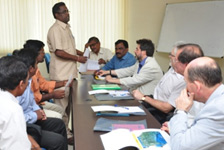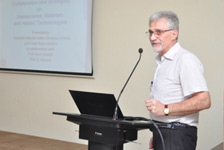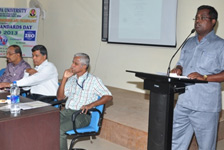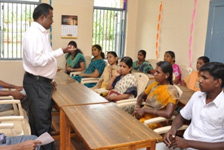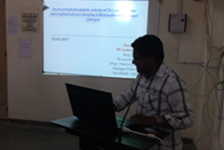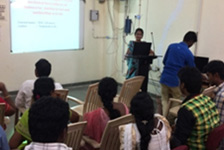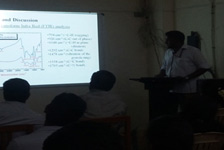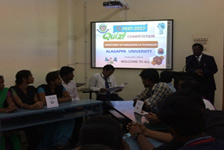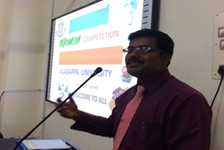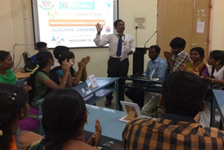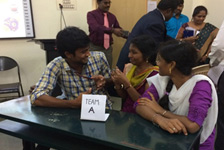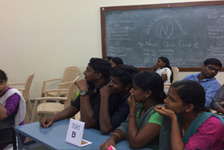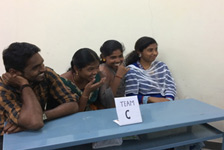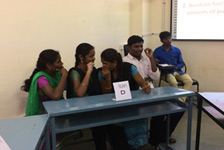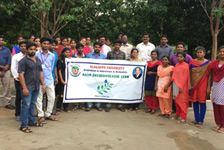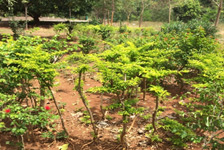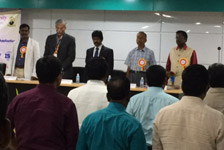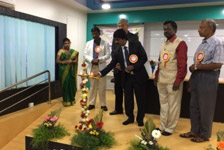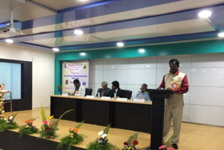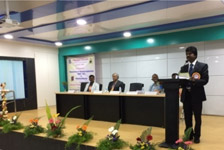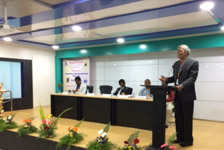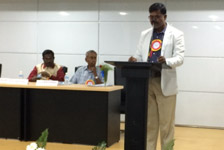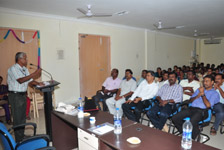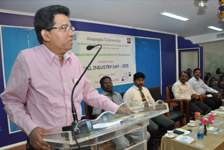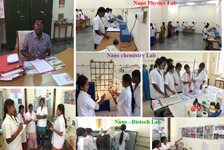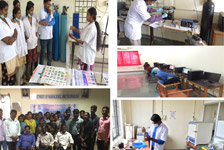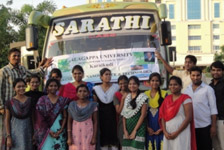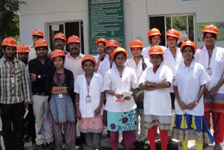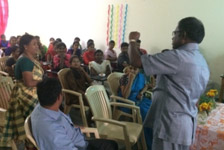Department of Nanoscience and Technology
School of Chemical Sciences
Department of Nanoscience and Technology
Nanotechnology is a fundamental, enabling and emerging technology which allow us to do new things in almost every conceivable technological discipline. Nano means ultra-small (10-9 M) but of high potency and emerging with large number of applications piercing through all the discipline of knowledge, leading to Industrial & Technological growth.
Considering the importance &wide applications of Nanotechnology, a unique seat of learning this subject Department of Nanoscience and Technology ALAGAPPA UNIVERSITY has been established in May 2008. The department of Nanoscience and Technology (DNST) the programme comprises of M.Sc. (Nanoscience &Technology [NST]), M.Sc ( Chemistry) with Specialization in NST, M.Phil. (NST) and Ph.D. (NST), in the field of Nanoscience and Technology. Our eminent faculties taking care of teaching and guiding the students in the frontier areas of Nanoscience & Nanotechnology and they have drawn a noteworthy syllabus for the entire Programs. The department has high impact in the field of Nano-Research activities.
Thrust area of research
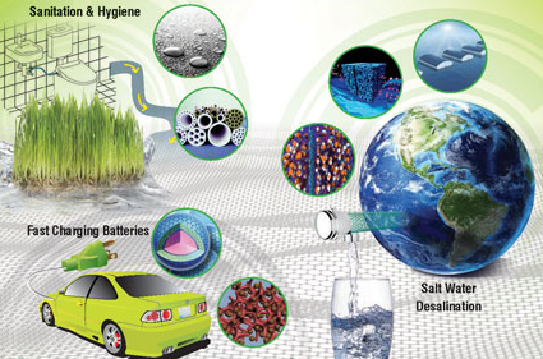
Hydrogen Energy, Photocatalysis, Nanomaterials for Electronics and Power sources, Conducting Polymers and their composites, Nanomagnetism, Core-shell based solar cells and Magnetism, Nanomaterials for Energy Applications, Bio-molecule Sensors, Semiconductor Quantum Dots (QDs), photonics device fabrication, Luminescent Nanoparticles, QDs for bio-medical imaging, Nanomedicine, Nano-marine biology and Pharmaceutical science and Nano-Toxicology.
Research Funding
Department of Nanoscience and Technology has sponsored projects from various funding agencies such as UGC- New Delhi, DST-SERB, European Union, DBT, ICMR, AURF and Confederation of Indian Industry (CII).
National/International Collaborations
DNST is association with national/international research institute and universities. Central electro chemical research institute (CECRI)-Karaikudi, Bose institute-Kolkata, Defense Institute of Advanced Technology (DIAT)-Pune, Defence materials Research Lab.(DMRL), Hyderabad, Bhanaras Hindu University-IIT, Varanasi, Yonsei University, Seol, S. Korea, National Taipei University of Technology, Taipei, Taiwan, Pohang University, S. Korea, Dongguk University, Gyeongju, S. Korea KUN-University, South Korea.
Contact Us
Dr. K. Gurunathan
Professor and Head
5th Floor, Science Campus
Department of Nanoscience and Technology
Alagappa University, Karaikudi - 630 003
Tamil Nadu, India.
Phone: +91-4565-225630, +91-4565-229449
E-Mail: kgnathan27@rediffmail.com
Faculty
Faculty
Programmes Offered
Programmes Offered
| Sl.No. | Course | Specialization | Mode of Study | Duration ( Years) |
|---|---|---|---|---|
| 1 | M.Sc. Nanoscience and Technology |
- | Full-Time | 2 |
| 2 | M.Sc. Chemistry |
Nanoscience and Technology | Full-Time | 2 |
| 3 | M. Phil. Nanoscience and Technology |
- | Full-Time | 1 |
| 4 | Ph. D. | Nanoscience and Technology & With Core Sciences- Interdisciplinary | Full-Time & Part-Time | Minimum of 2 years with M.Phil and 3 years with M.Sc. |
M.Sc., Nanoscience and Technology(NST)
Program objectives
Nanotechnology is one of the key technologies of the 21st century. The current and future fields of application of nanotechnology are electronics, mechanical engineering, biomedical, satellite, automobile and pharmaceutical industries, the field of new materials and environmetal technology. One academic course is necessary to create awareness to students in the emerging field and also it should teach basics, concepts and developments of nanoscience to students to make them as scientist or technologists in this filed. Hence, our task is to introduce the M.Sc programme in Nanoscience& Technology to educate the undergraduate students in the fascinating fields. Rigorous and comprehensive in approach, this syllabus presents essential contents in a detailed, clear and direct way.
This programme is offered under Choice Based Credit System (CBCS). The CBCS enables the students to select variety of subjects as per their interest and requirement. Acquiring knowledge in the related fields is advantageous to the students. Fast learners can earn more credits than the stipulated minimum of 72 credits. The programme is structured in such a way to impart more knowledge in science, in particular in Chemistry.
Eligibility
A candidate who has passed B.Sc., Degree Examination with Mathematics, Physics, Chemistry and Biology as main subject of study of any university or any of the B.Sc., degree examination with specialization such as Applied Mathematics, Applied Physics, Electronics, Nuclear Physics, Biophysics, Industrial chemistry, Polymer Chemistry, Applied Chemistry, Pharmaceutical Chemistry, Biotechnology, Nanoscience, Nanobiotechnology, Biochemistry and Micro-biology or any other specialization in Mathematics, Physics, Chemistry and Biology and B.E/B.Tech in Nanotechnology, Biotechnology and Bioinformatics, Electronics and Communication and Bio-Medical of some other university accepted by the syndicate as equivalent there to, subject to such condition as may be prescribed therefore shall be permitted to appear and qualify for the M.Sc. Degree in Nanoscience and Technology of this University after a course of study of two academic years.
Selection Procedure
As per our Alagappa University admission procedure.
Programme structure(Course of Study)
M.Sc. Nanoscience and Technology (CBCS - Structure of the Course)
| S.No | Paper Code | Title of the Paper | Hours | L | T | P | C |
|---|---|---|---|---|---|---|---|
|
Core Courses
|
|||||||
|
I Semester
|
|||||||
| 1. | 533101 | Basics of Mathematics and Quantum Mechanics | 72 | 4 | 0 | 0 | 4 |
| 2. | 533102 | Basics of Materials Science | 72 | 4 | 0 | 0 | 4 |
| 3. | 533103 | Basic Biotechnology | 72 | 4 | 0 | 0 | 4 |
| 4. | 533104 | Introduction to Nano Science | 72 | 4 | 0 | 0 | 4 |
| 5. | Major Elective – I | 72 | 4 | 0 | 0 | 4 | |
| 6. | 533107 | Nano Science and Technology Lab – I ( Nanophysics Experiments) | 108 | 0 | 0 | 6 | 6 |
| II Semester | 26 | ||||||
| 7. | 533201 | Synthesis of Nanomaterials | 72 | 4 | 0 | 0 | 4 |
| 8. | 533202 | Characterization of Nanomaterials | 72 | 4 | 0 | 0 | 4 |
| 9. | 533203 | Applications of Nanomaterials | 72 | 4 | 0 | 0 | 4 |
| 10. | *Major//Non-major Elective – II | 54 | 4 | 0 | 0 | 4 | |
| 11. | 533207 | Nano Science and Technology Lab – II (Nano-chemistry Experiments) |
108 | 0 | 0 | 6 | 6 |
| III Semester | 22 | ||||||
| 12. | 533301 | Nano Biotechnology and Nano Medicine | 72 | 4 | 0 | 0 | 4 |
| 13. | 533302 | Nanoelectronics and Nanodevice | 72 | 4 | 0 | 0 | 4 |
| 14. | 533303 | Nanoengineering | 72 | 4 | 0 | 0 | 4 |
| 15. | Major Elective – III | 54 | 4 | 0 | 0 | 4 | |
| 16. | Non-major Elective -V | 54 | 4 | 0 | 0 | 4 | |
| 17. | 533307 | Nano Science and Technology Lab – III (Nano-biotechnology Experiments) | 108 | 0 | 0 | 6 | 6 |
| IV Semester | 26 | ||||||
| 18. | Core course Elective – IV | 54 | 4 | 0 | 0 | 4 | |
| 19. | 533999 | Project - Report & Viva voce | 324 | 0 | 0 | 18 | 12 |
| 16 | |||||||
| Total Credits: 26+22 +26 +16 = 90 | |||||||
|
Elective Courses
|
|||||||
| 1. | 533501 | Thin FilmTechnologies and Characteristics | 54 | 4 | 0 | 0 | 4 |
| 2. | 533502 | Condensed Mater Physics | 54 | 4 | 0 | 0 | 4 |
| 3. | 533503 | Microsystem Technology | 54 | 4 | 0 | 0 | 4 |
| 4. | 533504 | Information Storage Materials and Devices | 54 | 4 | 0 | 0 | 4 |
| 5. | 533505 | Computer Simulation and Modelling | 54 | 4 | 0 | 0 | 4 |
| 6. | 533506 | Polymer nanocomposites | 54 | 4 | 0 | 0 | 4 |
| 7. | 533507 | Nanobiomaterials and nanobiotechnology for tissue engineering | 54 | 4 | 0 | 0 | 4 |
| 8. | 533508 | Nanotoxicology | 54 | 4 | 0 | 0 | 4 |
|
* Supportive Courses for other Departments
|
|||||||
| 1. | 533701 | Physics and Chemistry of Nanomaterials | 54 | 4 | 4 | 0 | 4 |
| 2. | 533702 | Synthesis and Characterization of Nanomaterials | 54 | 4 | 4 | 0 | 4 |
| 3. | 533703 | Introduction to Nano Scale in Science and Technology | 54 | 4 | 4 | 0 | 4 |
| 4. | 533704 | Nanomedicine and drug delivery | 54 | 4 | 4 | 0 | 4 |
| 5. | 533705 | Introductory to bio-informatics | 54 | 4 | 4 | 0 | 4 |
Note: C – Core Courses, E – Elective Courses & S – Supportive Courses; L – Lecture, Tutorial, P – Practical, C-credit
M.Sc., Chemistry with Specialization in Nanoscience and Technology
Program Objectives
The programme is named Branch IV (b) - M.Sc. Chemistry-Specialization in Nanoscience and Technology CBCS). The syllabus for this programme is framed under the rules of the Choice Based Credit Semester System of this University and both Core- and Elective courses were incorporated as its components. The CBCS enables the students to select variety of subjects as per their interest and requirement. Acquiring knowledge in the related fields is advantageous to the students. Fast learners can earn more credits than the stipulated minimum of 90 credits.
All basic life forms on Earth depend greatly on chemistry for their survival, including us. Chemistry is a big part of your everyday life. We find chemistry in daily life in the foods we eat, the air we breathe, our soap, our emotions and literally every object we can see or touch. Without chemistry it would be extremely hard for us to live. We need chemistry and chemicals for everything we do.
Chemistry is a pervasive subject. All the branches of science need chemistry. It is an experimental science and students need to train in practicals to get expertise in doing fine experiments and handle sophisticated instruments. Along with the data obtained its statistical analysis is also required to establish authenticity in the fields like environmental science, space chemistry and biotechnology. There are immense potentialities for chemistry and post graduates to undertake advanced research or in Industries as skilled chemists. It is important for the educators to provide a platform for the student community to study in detail the basics and advancements in chemistry. Hence our goal in floating the M.Sc programme in Chemistry-Specialization in Nanoscience and Technology is to educate the undergraduate students of chemistry in the fascinating fields of chemistry in an effective manner. This syllabus presents essential contents in a detailed, clear and direct way.
The major objectives of M.Sc. Chemistry-Specialization in Nanoscience and Technology are:
- To provide, thorough well designed studies of theoretical and experimental chemistry, a worthwhile educational experience for all students
- To acquire deep knowledge in fundamental aspects of all branches of chemistry
- To acquire basic knowledge in the specialized thrust areas like Photoelectrochemistry, Materials Chemistry, Chemistry in Nanoscience and Technology etc. and
- To develop abilities and skills that:
- are relevant to the study and practice of science,
- are useful in everyday life,
- are encouraging efficient and safe practice and effective communication.
- To develop attitudes relevant to science such as:
- Concern for accuracy and precision,
- Objectivity,
- Integrity,
- Enquiry,
- Initiative and
- Inventiveness.
Eligibility For Admission
A candidate who is a B.Sc. graduate of this University or any recognized University in the main subject/subjects as given below or who has passed an examination accepted by the Syndicate as equivalent there to is eligible for admission to M.Sc. Chemistry- Specialization in Nanoscience and Technology programme.
| M.Sc. Chemistry-Specialization in Nanoscience and Technology | B.Sc., Degree Examination with Chemistry / Special Chemistry / Industrial Chemistry / Textile Chemistry / Electrochemistry / Applied Chemistry / any other specialization in Chemistry as main subject of study and any two of Mathematics, Physics, Botany, Zoology, Computer Application, Microbiology, Textile Chemistry, Electrochemistry, Applied Chemistry as ancillary subjects |
The admission is subject to the prevailing rules and regulations for PG admission of this University. The candidate has to undergo this programme in the Department of Nanoscience and Technology, Alagappa University and complete all the examinations prescribed under the four semesters to qualify for this degree.
Duration Of The Programme
The programme is for a period of two years. Each year shall consist of two semesters viz. Odd and Even semesters. Odd semesters shall be from July to November and even semesters shall be from December to April. There shall be 90 working days which shall comprise 540 teaching clock hours for each semester (exclusive of the days for the conduct of University end semester examination).
Courses In The Programme
M.Sc. Chemistry-Specialization in Nanoscience and Technology programme consists of number of courses. The term ‘course’ is applied to indicate a logical part of the subject matter of the programme and invariably equivalent to the subject matter of a “paper” in the conventional sense.
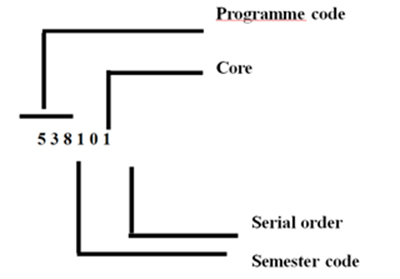
For elective, the fourth digit is ‘5’
Program Structure ( Course of Study)
M.Sc. Chemistry-Specialization In Nanoscience And Technology
| Sem | Course Code | Course Title | Credit | Hrs | CIA Marks | ESE Marks | Total Marks |
|---|---|---|---|---|---|---|---|
| I | 538101 | Inorganic Chemistry -I | 4 | 5 | 25 | 75 | 100 |
| 538102 |
Organic Chemistry -I |
4 | 5 | 25 | 75 | 100 | |
| 538103 |
Physical Chemistry -I |
4 | 5 | 25 | 75 | 100 | |
|
538107 |
Inorganic Chemistry Practical |
4 | 6 | 25 | 75 | 100 | |
| Elective I (Introduction to Nanoscience and Technology) | 4 | 5 | 25 | 75 | 100 | ||
| Elective II (Environmental Green Chemistry) | 4 | 4 | 25 | 75 | 100 | ||
|
Total
|
24 | 30 | 150 | 450 | 600 | ||
| II |
538201 |
Inorganic Chemistry -II | 4 | 5 | 25 | 75 | 100 |
|
538202 |
Organic Chemistry -II |
4 | 5 | 25 | 75 | 100 | |
|
538203 |
Physical Chemistry -II |
4 | 5 | 25 | 75 | 100 | |
|
538207 |
Organic Chemistry Practical |
4 | 6 | 25 | 75 | 100 | |
| Elective III (Synthesis and analysis of nanomaterials) | 4 | 5 | 25 | 75 | 100 | ||
| Elective IV Supportive course(Physics and Chemistry of Nanomaterials) | 4 | 4 | 25 | 75 | 100 | ||
|
Total
|
24 | 30 | 150 | 450 | 600 | ||
| III |
538301 |
Inorganic Chemistry -III | 4 | 5 | 25 | 75 | 100 |
|
538302 |
Organic Chemistry -III |
4 | 5 | 25 | 75 | 100 | |
|
538303 |
Physical Chemistry -III |
4 | 5 | 25 | 75 | 100 | |
|
538304 |
Nanomaterials Characterization Techniques |
4 | 4 | 25 | 75 | 100 | |
|
538308 |
Physical Chemistry Practical |
4 | 5 | 25 | 75 | 100 | |
| Elective V Supportive course (Applications of Spectroscopy in Materials Chemistry) | 4 | 6 | 25 | 75 | 100 | ||
|
Total
|
24 | 30 | 150 | 450 | 600 | ||
| IV |
538401 |
Application of Nanotechnology |
4 | 5 | 25 | 75 | 100 |
|
538407 |
Practical IV Nanoscience and Technology |
4 | 6 | 25 | 75 | 100 | |
|
538999 |
Elective VI (Nanocomposites) |
4 | 4 | 25 | 75 | 100 | |
|
|
Project Work -Report & Viva-voce |
6 | 15 | 25 | 75 | 100 | |
|
Total
|
18 | 30 | 100 | 300 | 400 | ||
|
GRAND TOTAL
|
90 | 120 | 550 | 1650 | 2200 | ||
Elective Courses
| Course Code | Course Title |
|---|---|
| 538501 | Introduction to Nanoscience and Technology |
| 538502 | Environmental Green Chemistry |
| 538503 | Synthesis and Analysis of Nanomaterials |
| 538504 | Nanocomposites |
Supportive Courses For Other Departments*
| Sl. No. | Course Code | Course Title | Credit | CIA Marks |
ESE Marks |
Total Marks |
|---|---|---|---|---|---|---|
| 1. | 538701 | Physics and Chemistry of Nanomaterials | 4 | 25 | 75 | 100 |
| 2. | 538702 | Application of Spectroscopy in Materials Chemistry | 4 | 25 | 75 | 100 |
*Depending upon the requirement, any one of the above courses will be floated in a semester.
M. Phil., in Nanoscience and Technology
Eligibility
Candidates for admission to Master of Philosophy in Nanoscience and Technology ( M. Phil] should have Master of Science in Nanoscience & Technology or M.Tech (Nanotech) from a recognised University and must have obtained 55% marks at graduation level (OR) M.Sc. in any branch of Physical Sciences and life sciences.
Duration of the Course
The course shall extend over a period of one year under Semester Pattern accounting to two Semesters.
Standards of Passing and award of Division
- The minimum marks for passing in each theory course shall be 50% of the marks prescribed for the paper.
- A candidate who secures 50% or more marks but less than 60% of the aggregate marks prescribed for four semesters taken together, shall be awarded SECOND CLASS
- A candidate who secures 60% or more of the aggregate marks prescribed for four semesters taken together, shall be awarded FIRST CLASS.
- The Project shall be assessed by one external examiner appointed by the University and guide should be internal examiner
Admission
Admission shall be based on Entrance Examination conducted on the following criteria
- Entrance Examinations Question Paper shall be in following pattern
- A candidate may answer a maximum of 100 questions
- Duration of Examination shall be two hours.
Program Structure
M.Phil. (Nanoscience and Technology) programme [Choice Based Credit System (CBCS)]
| Sl No | Paper Code | Title of the Paper | Exam Hours | I | E | T | C |
|---|---|---|---|---|---|---|---|
|
Core Courses
|
|||||||
|
Semester-I
|
|||||||
| 1. | 507101 | Research Methodology and Basic of Nanoscience | 3 | 40 | 60 | 100 | 6 |
| 2. | 507102 | Perspectives of Nanoscience & Nanotechnology | 3 | 40 | 60 | 100 | 6 |
| 3. | 507103 | General skills in Science | 3 | 100 | - | 100 | 6 |
|
Semester-II Elective Courses (Any one)
|
|||||||
| 4. | 507201 | Nanomaterials for Power sources and Magnetic devices | 3 | 40 | 60 | 100 | 6 |
| 5. | 507202 | Polymer Nanocomposites | 3 | 40 | 50 | 100 | 6 |
| 6. | 507203 | Nano marine Biology | 3 | 40 | 60 | 100 | 6 |
| 7. | 507204 | Semiconductor Optoelectronics | 3 | 40 | 60 | 100 | 6 |
| 8. | 507205 | Nanopharmacology and Toxicology | 3 | 40 | 60 | 100 | 6 |
| - | 507999 | Dissertation work and Viva voices | - | 50 | 150 | 200 | 12 |
|
Total Marks
|
600 | ||||||
|
Total Credit
|
36 | ||||||
Syllabus
Fee Structure
Fee Structure
| Program | Tuition Fee include. Rs. | Computer Lab Fee Rs. | Spl. Fee Rs. | Other Fee Rs. | Special Lecture & Ind. Visit Rs. | I year Total Fee Rs. | II year Total Fee Rs. |
|---|---|---|---|---|---|---|---|
| M.Sc ( NST) | 1000 | 2000 | 2000 | 1000 | 500 | 6500 | 5500 |
| M. Sc. (Chemistry with NST) | 1000 | 500 | 2000 | 1000 | - | 4500 | 3500 |
| M. Phil (NST) | 5000 | 2000 | 2000 | 1000 | - | 10000 | - |
| Ph. D (NST) | 3000 (regn.) | 1500 | 6000 (Ann. Res.) | 4000 (course & Compre.) | - | 14500 | 14500 |
Facilities
Facilities
Nano-Gas Sensor –Set-up, UV-VIS Spectrophotometer, Cycle Tester, Spin Coater, Furnaces and Impedance Spectroscopy, Bomb Calorimeter and Microscope.
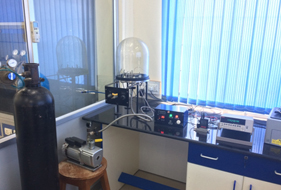
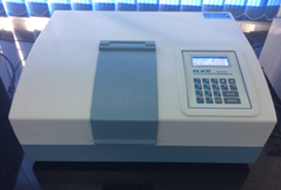
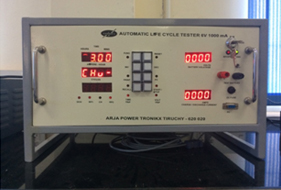
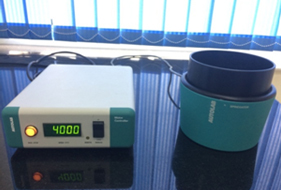
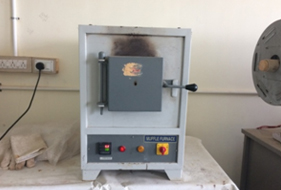
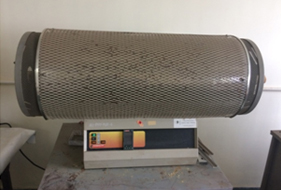
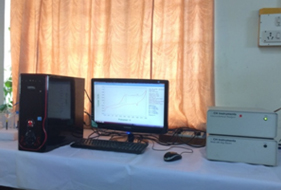
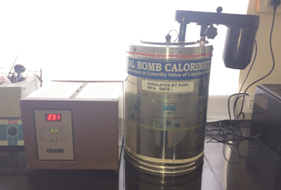
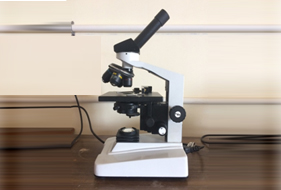
Internet Facility

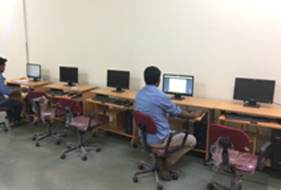
M.Sc Chemistry Practical Lab
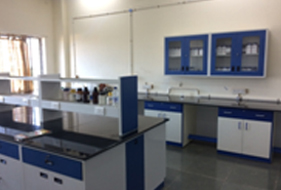
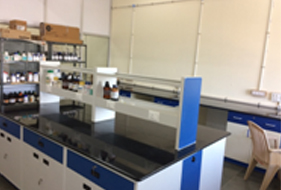
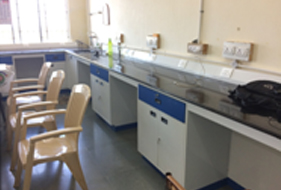
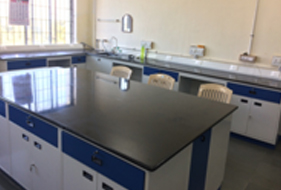
Nano Physics Lab
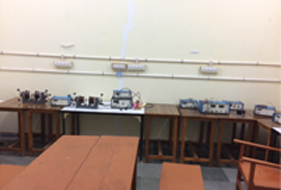
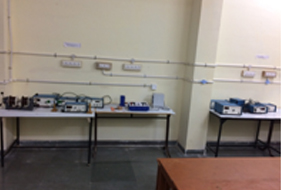
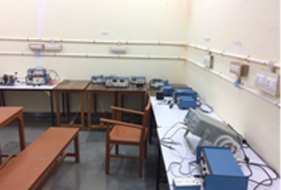
Nano Biotechnology Lab
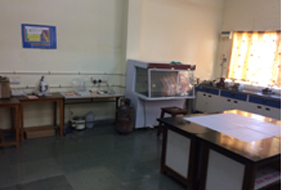
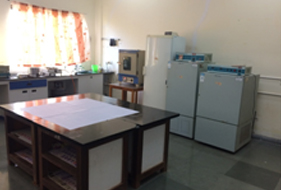
Research
Research
Fellowships Availed/Availing by Research Scholars and Project Fellow
| S. No. | Research Scholar | Fellowship |
|---|---|---|
| 1 | S. Sasikala | RG-UGC-JRF |
| 2 | A. Rajesh | DST-Purse |
| 3 | K. Dhanabalan | UGC-PF |
| 4 | V.S. Venkatesh | UGC-PF |
| 5 | K. Gopinath | UGC-PF |
| 6 | J. Suganya | DST-JRF |
| 7 | R. Kalyani | AURF |
| 8 | M.Rajesh | RG-UGC-JRF |
| 9 | M. Kavitha | PM-JRF |
| 10 | A. Srinivasan | DST-Project Fellow |
| 11 | S. Sivasakthi | AURF |
Research Interest
Details of Research Projects
COMPLETED PROJECTS
| Sl. No. | PRINCIPAL INVESTIGATOR | PROJECT TITLE | PROJECT PERIOD | FUNDING AGENCY | TOTAL GRANT Rs. in Lakhs |
|---|---|---|---|---|---|
| 1 | Dr. K.Gurunathan | Photobiological Hydrogen production and fabrication of Microbiofuel cell | 2011-2014 | UGC | 5.48 |
| 2 | Dr. R. Ilangovan | Fabrication of Nanosensors for reactor application | 2011-2014 | UGC | 7.28 |
| 3 | Dr. A. Arumugam | Nanosensor Development for Bacterial Pathogen | 2011-2012 | AURF | 0.64 |
| 4 | Dr. P. Shakkthivel | Synthesis of Magnetic materials synthesis and Characterization | 2011-2012 | AURF | 0.64 |
| 5 | Dr. R. Ilangovan | Fabrication of Nanosensors | 2011-2012 | AURF | 0.64 |
| 6 | Dr. A. Arumugam | Micro propagation and germ plasam conservation of endangered medicinal plants in Southern India | 2010-2013 | UGC | 11.23 |
| 7 | Dr. P. Shakkthivel | Nanoparticle cathode material synthesis and the performance evaluation in Li-ion cells. | 2009- 2012 | DST | 19.97 |
| 8 | Dr. P. Shakkthivel | Novel heterogeneous nanocatalysts for bio-diesel synthesis from vegetable oils. | 2010- 2013 | UGC | 8.14 |
ON-GOING PROJECTS
| Sl. No. | PRINCIPAL INVESTIGATOR | PROJECT TITLE | PROJECT PERIOD | FUNDING AGENCY | TOTAL GRANT Rs. in Lakhs |
|---|---|---|---|---|---|
| 1. | Dr. P. Shakkthivel | Novel conducting C layer embedded LMO hollow nano-spheres assembly for hybrid-electric vehicle application. | 2016 -2019 | DST-SERB | 23.26 |
| 2. | Dr. G. Ramalingam | Fabrication of one dimensional (1-D) nanomaterials with Quantum Dots (QDs) for solar cell application | 2017-2020 | DST-SERB | 25.00 |
| 3. | Dr. N. Suganthy | Neuroprotective efficacy of Nanoencapsulated multi-potent phyto-drug 7-Methyl-Gallic acid and Methyoxy-coumarin against b-amyloid induced toxicity-Towards a novel drug delivery for combating Alzheimer’s disease | 2017-2019 | UGC start- up Grant | 10.00 |
| 4. | Dr. K. Gurunathan | Design and Development of Nanosensors for Medical Diagnosis | 2017 | AURF | 3.00 |
| 5. | Dr. G. Ramalingam | Quantum dots for Bio-imaging Applications | 2017 | AURF | 1.00 |
Research Publications Since 2011
| 1 | R. Kalyani, K. Gurunathan ( 2016), Quantum Confinement Regime Of Mo- Polymer Nanostructures And The Inclusion Of r-GO Forming Effective Combination For Photocatalytic Applications, Chem. Select, 1(16), 5230-5235 |
| 2 | R. Kalyani, K. Gurunathan (2016), Intercalated Network Of Graphene Oxide (GO)-CuO- Polythiophene (Pth) Hybrid Nanocomposite For Photocatalytic Applications, J. Materials Science : Materials for Electronics 27(10), 10634-10641 |
| 3 | R. Kalyani and K. Gurunathan (2016), "PTh-rGO-TiO2Nanocomposite for Photocatalytic Hydrogen Production and Dye Degradation" J. Photochemistry and Photobiology A: Chemical 329, 105-112 |
| 4 | Kalyani R, Gurunathan K ( 2016), Nano – A Splendid Material for Overwhelming the Hurdles of Hydrogen (H2)Production, Kenk Nanotech. Nanosci 2: 9-11 (2016) |
| 5 | R. Kalyani, K. Gurunathan ( 2016) "A Review on Plastic (Flexible) Solar Cells, Kenkyu J Nanotec Nanosci 1: 100114 |
| 6 | R. Kalyani and K. Gurunathan (2016) "Metal Ions Doped & Polythiophene Coated Nanophotocatalysts: Synthesis And Spectroscopic Characterization For H2 Production And Dye Degradation"Optik127,4741-4745 |
| 7 | R. Kalyani, G. Chockalingam and K. Gurunathan (2016), " Tribological aspects of Metal and Metal oxides Nanoparticles Advanced Science, Engineering and Medicine, 8, 228-232. |
| 8 | R. Kalyani and K. Gurunathan (2015), "Graphene oxide based nanocomposites for nanotechnological applications" Kenkyu J. Nanotec. Nanosci. 1:100101. |
| 9 | R. Kalyani and K. Gurunathan (2015), Spectroscopical Studies on Chemically Synthesized Photoactive Nano Transition Metal Semiconductor Interfaces, Kenkyu J. Nanotechnology and Nanoscience, 1:100107 |
| 10 | K. Dhanabalan and K. Gurunathan (2015), Photobiocatalytic Hydrogen Production by using Cyanobacteria coupled with Nanoparticles of CdS and CdS/ZnS, Advanced Science, Engineering and Medicine, 7, 667-671 |
| 11 | T. Sadhasivam and K. Gurunathan (2015), Role of nano sized particles, catalytic additives and alternative/advanced techniques on Magnesium Hydride |
| 12 | A. Rajesh, M. Manivel Raja and K. Gurunathan (2014), Structural and magnetic Characterizations of Hydroxy apatite- ?-Fe2O3 core-shell Nanoparticles, Advanced Science, Engineering and Medicine 6,1171-1176 |
| 13 | A. Rajesh, Alo Dutta, K. Gurunathan and T. P. Sinha (2015), Dielectric relaxation of NiFe2O4/Gd2O3 Core-Shell nanoparticles, J. Nanoscience & Nanotech., 15,6082-6087. |
| 14 | T. Sadhasivam and K. Guruanthan (2015), "A facile synthesis and thermal properties of Graphene Oxide – Mischmetal Oxide nanocomposites, J. Nanoscience & Nanotech 15, 5676-5683. |
| 15 | K. Dhanabalan and K. Gurunathan (2014) , Size selective separation of CdS nanoparticles functionalized by methy methacrylate, Ciencia e Tecnica Vitivinicola' journal, 29 (8), 253-284 |
| 16 | A. Rajesh, M. Manivel Raja, Sujoy Saha, T. P. Sinha and K. Gurunathan (2014), " Synthesis, Physico-chemical and Electrical Characterizations of Graphene oxide-Hydroxyapatite Nanocomposites" Advanced Science, Engineering and Medicine 6(10), 1076-1081 |
| 17 | K. Dhanabalan and K. Gurunathan (2015), Neutral Microemulsion mediated synthesis and characterization of CdS NPs and its anti-biofilm efficacy against Escherichia coli ATCC 25922, J. Nanoscience & Nanotechnology 15, 4200-4204. |
| 18 | S. .Muthukkumarasamy and K.Gurunathan (2014), Eco-friendly Synthesis of Silver Nanoparticles using Cardiospermum helicacabum L and its antibiofilm activity against Escherichia coli, Advanced Science, Engineering and Medicine 6(7), 765-770. |
| 19 | A. Rajesh, M. Manivel Raja and K. Gurunathan (2014), "Spin-Relaxation Studies of NiO Encapsulated Gd2O3 Core-Shell Nanoparticles" Acta Metallurgica Sinica, 27(2), 253-258 |
| 20 | A.Rajesh, Alo Dutta, K. Gurunathan, T.P. Sinha (2014), Spin relaxation of Gd2O3/NiFe2O4 core-shell nanoparticles, Nanoscience and Nanotechnology Letter 6(5), 450-455. |
| 21 | T. Sadhasivam, M. Sterlin Leo Hudson, Sunita K. Pandey, Ashish Bhatnagar, Milind K Singh, K. Gurunathan and O. N. Srivastava (2013) , Effects of nano size mischmetal and its oxide on improving the hydrogen sorption behaviour of MgH2, Int. J. Hydrogen Energy, 38, 7352-7362 |
| 22 | A. K. Chakravarthy, Chandrashekharaiah, Subhash B. Kandakoor, Atanu Bhattacharya, K. Dhanabalan, K. Gurunathan and P. Ramesh (2012), Bio efficacy of inorganic nanoparticles CdS, Nano-Ag and Nano-TiO2 against Spodoptera litura (Fabricius) (Lepidoptera: Noctuidae), Current Biotica 6(3), 271-281 |
| 23 | K. Dhanabalan, Pawan Khanna, K. Gurunathan, N. Reji, V. Sowmya and V. Renugopalkrishnan (2012), Mild synthesis of Fe2O3/CdS nanoparticles and their magneto-luminescence studies, Int. J. Green Nanotechnology 4, 457-462 |
| 24 | P. Ramesh and K. Gurunathan (2012), Nanomaterials communication inside the living organism, Nanocommunication Networks 3, 452-456 ( Review) |
| 25 | P. Ramesh, S. M. Samy, K. Dhanabalan, K. GURUNATHAN (2012), Synthesis And Characterization Of Ag And Tio2 Nanoparticles And Their Anti-Microbial Activities, Digest J. Nanomaterials and Biostructures 7( 4), 1501-1508 |
| 26 | S. M. Samy, A.Sharadha, S.Vignesh, K. Dhanabalan And K.Gurunathan (2012), Extracellular Synthesis Of Polygonal Silver Nanoparticles Using Extract Of Escherichia Coli Atcc 25922 And Its Antibacterial Activities, Digest J. Nanomaterials and Biostructures 7( 4), 1419-1426 |
| 27 | K. Dhanabalan, S. Muthukumarasamy and K. Gurunathan (2012) "Cationic Micelles Capped Nanosized CdS Synthesis And Characterization" Chalcogen Letters 9(6),243-248 |
| 28 | Ramesh P, Muthukkumarasamy S, K.Dhanabalan, T.Sadhasivam and K.Gurunathan (2011), Nanotechnology: Application, Nano-hazard and its Toxic effects, E-Journal of Life Sciences,1(1),30 -38 |
| 29 | Shakkthivel Piraman, Sasikala Sundar, Ramalakshmi Mariappan, and Kim Min, "Facile biosurfactant assisted biocompatible a-Fe2O3 nanorods and nanospheres synthesis, magneto physicochemical characteristics and their enhanced biomolecules sensing ability" RSC Advances, 2016,6, 77133-77142 |
| 30 | Shakkthivel Piraman, Maruthaiya Karupaiah, Ramalakshmi Mariappan, Srinivasan Alagar, Kim Min, "Novel CaCO3-Polymer Nanocomposite Fillers for the improvement of Bagasse based Papers" TAPPI Journal (Accepted June 2016) |
| 31 | Shakkthivel Piraman, Sasikala Sundar, Ramalakshmi Mariappan, Young Yun Kim, Kim Min, "Nanospheres and nanoleaves of g-Fe2O3 architecturing for magnetic and biomolecule sensing applications" Sensors and Actuators B – Chemical, B 234 (2016) 396-394. |
| 32 | Maruthaiya Karuppaiah, Sasikala Sundar, Ramalakshmi Mariappan, Rajesh Madhuvilakku, Manisankar Paramasivam, Shakkthivel Piraman "Improvement of Bagasse based Paper Properties using Definite Size Effect of CaCO3 Nanofillers" "International Journal of Scientific Research, 5, 3 (2016) 16-18. |
| 33 | Sasikala Sundar and Shakkthivel Piraman , "Greener saponin induced morphologically controlled various polymorphs of nanostructured iron oxide materials for biosensor applications" RSC Advances., 5 (2015) 74408-74415 |
| 34 | A.T.Ezhil Vilian, S M Chen and Shakkthivel Pirman, "The electrochemical synthesis of Pt particles on ZrO2-ERGO modified electrodes with high electrocatalytic performance for methanol oxidation" New Journal of Chemistry, 39 (2015) 953-961. |
| 35 | A. T. Ezhil Vilian, Muniyandi Rajkumar, Shen-Ming Chen, Chi-Chang Hu and Shakkthivel Piraman, "A promising photoelectrochemical sensor based on a ZnO particle decorated N-doped reduced graphene oxide modified electrode for simultaneous determination of catechol and hydroquinone" RSC Adv., 4 (2014) 48522-48534. |
| 36 | S. .Maikannu, M. Kashif, N. sethupathy. V.S. Vidhya Shakkthivel Piraman, A. Ayeshamariam, M. Bououdina, Naser M. Ahamed, M. Jayachandran. "Effect of substrate temperature on indium tin oxide (ITO) thin films deposited by jet nebulizer spray pyrolysis and solar cell application" Materials Science in Semiconductor Processing, 27 (2014)562-568. |
| 37 | S. Marikkannu, A. Ayesha mariyam, V.S. Vidhya, N. Sethupathy and Shakkthivel Piraman, "Preparation of characterizations of ITO thin flims with different Sn concentration by Jet Nebuliser technique" Journal on Photonics and Spintronics, vol. 3, 2 (2014) 8572-8580. |
| 38 | S. Marikkannu, M. Kashif, A. Ayesha Mariyam, N. Sethupathy, V.S. Vidhya, S. Piraman and M.Jeyachandran, "Studies on Jet Nebulizer pyrolysed Indium Oxide Thin flims" Journal of Ovonic Research, Vol. 10, 4 (2014) 115-125. |
| 39 | Ramalakshmi Mariappan, Min Kim and Shakkthivel Piraman, "Mn3O4 Nanoparticle Synthesis Via Ionic Liquid –Assisted Route" J Superconductivity and Novel Magnetism, Vo.27 (2014)2595-2598. |
| 40 | Balamurugan Devadas, Huai-Tse Yeh, Shen-Ming Chen and Shakkthivel Piraman, "Electrochemical preparation of Yttrium hexacyanoferrate on reduced grapheme oxide and its application to analgesic drug sensor" Electroanalysis, 26 (2014) 1712-1720 |
| 41 | S. asikala Sundar, Ramalakshmi Mariappan and Shakkthivel Piraman, "Synthesis and characterization of amine modified magnetite nanoparticles as carriers of Curcumin-anticancer drug" Powder Technology, 26 (2014) 321-328. |
| 42 | Rajesh Madhu, Shen-Ming Chen, Selvakumar Palanisamy and Shakkthivel Piraman, "A low temperature synthesis of activated carbon from the bio waste for the simultaneous electrochemical detection of hydroquinone and catechol" J of Electroanalytical Chemistry, 727 ( 2014) 84-90. |
| 43 | S. uganya J, Ramalakshmi M, Sasikala S and Shakkthivel P, "Electrochemical behavior of LiMn2-X-YTiXFeYO4 as cathode material for lithium ion Batteries" J of Electroanalytical Chemistry, Vol.720-721, 15 (2014), 58-63. |
| 44 | Rajesh Madhuvillaku, Ramalakshmi Mariappan, Suganya Jeyapal, Sasikala Sundar , Shakkthivel Piraman, "Transesterification of Palm Oil Catalzed by Fresh water Bivalve Mollusk (Margaritifera Falcata) Shell as heterogeneous catalyst" Industrial and Engineering Chemistry Research, Vol.49, No.52, (2013), 17407. |
| 45 | Rajesh Madhuvillaku and Shakkthivel Piraman, "Biodiesel Synthesis by TiO2-ZnO mixed oxide nanocatalyst catalyzed Palm Oil transesterification process" Bioresource Technology" Vol.150, (2013) 55. |
| 46 | S. Marikkannu, N. Sethupathy, V.S. Vidhya and Shakkthivel Piraman, "Effect of temperature on indium tin oxide ITO thin flim deposited by Jet nebulizer spray pyrolysis" Journal of Applied Sciences Research, 9 (10) : 5541-5547, 2013. |
| 47 | Ramalakshmi M, Shakkthivel P,M.Sundrarajan, S.M.Chen "Novel method of Room Temperature Ionic Liquid Assisted Fe3O4 Nanocubes and Nanoflakes Synthesis" Materials Research Bulletin, Vol. 48, No.8, (2013) 2758. |
| 48 | S. uganya J, Ramalakshmi M and Shakkthivel P, "Dopant depends on morphological and electrochemical characteristics of LiMn2-xMoxO4 cathode nanoparticles" Journal of Solid State Electrochemistry, Vol. 17, (2013) 2157. |
| 49 | S. asikala Sundar, Shakkthivel Piraman, "Nanospheres of Fe3O4 synthesis through sol-gel technique and their structural and magnetic characterization" Indian journal of Applied Research, Vol.3, No.7 (2013) 123 |
| 50 | 1. New records of Pen Shells ( Bivalvia, Pinnidae) from seagrass beds of palk Bay area in Tamilnadu –Seaweed Res.Utiln,32(1&2):185-188,2010 |
| 51 | New Distribution of Siratus Virgineus ponderosus (Sowerby, 1879)Family Muricidae, in Mandapam Coast, India ,World Journal of Zoology 6 (4):331-333,2011 |
| 52 | Using Sem Studies on the Radular Morphology of Chicoreus Species (Gastropods:Muricidae) collected from Palk Bay in Tamilnadu-Ecology and Fisheries, Vol.4(2):73-78,2011 |
| 53 | Preparation and Physicochemical Characterization of Ag Nanorods Phytosynthesis by the Petroselinum crispum Plant Extract, C. Ragupathi, R. Azhagu Raj, G. Ramalingam, K. Arun Kumar, and N. Mohamed Basith, Advanced Science, Engineering and Medicine, Vol. 8, page 1–6, 2016 |
| 54 | Bio-Encapsulated CdSe/ZnSe Composite Nanorods, G. Ramalingam, J. Nanosci & Tech, 2 (2016) 130–133. |
| 55 | Synthesis, optical and morphological studies of Sol-Gel derived ZnO/PVP one dimensional Nanocomposite. S. Ravichandran, G.Ramalingam, J. Nanosci & Nanotech, 1 (2013) 39-43. |
| 56 | Electrical Behaviour of Polyethylene Vinyl Acetate/ZnO Nanocomposite, A.J. Edakkara, J.J. Mathen, J. Sebastian, G. Ramalingam, G.P. Joseph, Proceedings of The International Conference Nanomaterials: Applications And Properties, Vol. 2, No 3, NCNN (3pp) (2013). |
| 57 | Investigation on mild condition preparation and structural, optical and thermal properties of PVP capped CdS nanoparticles, N.S. Nirmala Jothi. G. Ramalingam, A.R. Baby Suganthi, Gunaseelan. R and P. Sagayaraj, Int. J. Semi & Tech, 2 (2012) 1-17. |
| 58 | Investigation on the structural and morphological behaviour of CdSe nanoparticles by hydrothermal method. G.Ramalingam and J. Madhavan, Archi. Appl.Sci Res 3 (2011) 217-224. |
| 59 | S. tructural and Optical property studies of CdSe crystalline nanorods synthesized by a solvothermal method G. Ramalingam, N. Melikechi, P. Dennis Christy, S. Selvakumar and P. Sagayaraj, J. Crys. Grow, 311 (2009) 3138-3142. 17 |
| 60 | Synthesis and Characterization of One Dimensional Semiconductor Nanorods And Nanobelts. G.Ramalingam, J.Madhavan, P.Sagayaraj, S.Selvakumar, R.Gunaseelan, R.Jerald Vijay, P.Sagayaraj, Trans.Indi. Instit .Mat, 64 (2011) 217-220. |
| 61 | S. uganthy N, Sheeja Malar D, Devi KP. (2016). In vitro antiaggregation and deaggregation potential of Rhizophora mucronata and its bioactive compound (+)- catechin against Alzheimer's beta amyloid peptide (25–35). Neurological Research, Taylor and Francis, 38/12, 1041-1051 |
| 62 | S. uganthy N, Sheeja Malar D, Devi KP. (2016). Rhizophora mucronata attenuates beta-amyloid induced cognitive dysfunction, oxidative stress and cholinergic deficit in Alzheimer's disease animal model. Metabolic Brain Disease, Springer, 31/4, 937-949 |
| 63 | S. uganthy N, Devi KP (2016). Nutritional Evaluation Of Asiatic Mangrove Rhizophora Mucronata – Its Proximate Composition, Amino Acid. International Journal of Pharmaceutical Sciences and Research. 7/6, 2537-2545 |
| 64 | S. uganthy N. Devi KP (2016). Protective effect of catechin rich extract of Rhizophora mucronata against ?-amyloid-induced toxicity in PC12 cells. Journal of Applied Biomedicine, Elseiver, 14, 137-146 |
| 65 | S. uganthy N, Devi KP, Nabavi SF, Braidy N, Nabavi SM. (2016). Bioactive effects of quercetin in the central nervous system: Focusing on the mechanisms of actions. Biomedicine and Pharmacotherapy 84, 892–908. |
| 66 | S. uganthy N, Devi KP. (2015). In vitro antioxidant and anti-cholinesterase activities of Rhizophora mucronata. Pharmaceutical Biology 9, 1-12. |
| 67 | S. uganthy N, Karthikeyan K, Archunan G, Pandian SK, Devi KP (2014). Safety and toxicological evaluation of Rhizopora mucronata (a mangrove from Vellar estuary, India): assessment of mutagenicity, genotoxicity and in vivo acute toxicity. Molecular Biology Reports 41(3), 1355-1371. |
Alumni
Association
Association
Committees, Associations, Clubs and Cells
| Committee | Conveners | Members |
|---|---|---|
| Research | Dr. K. Gurunathan | Dr. P. Shakkthivel |
| Dr. C. Balalakshmi | ||
| Dr. G. Ramalingam | ||
| Dr. N. Suganthy | ||
| Doctoral -- To approve Ph.D related recommendations |
Dr. K. Gurunathan | Dr. P. Shakkthivel |
| Dr. C. Balalakshmi | ||
| Dr. G. Ramalingam | ||
| Dr. N. Suganthy | ||
| Purchase | Dr. K. Gurunathan | Dr. P. Shakkthivel |
| Dr. C. Balalakshmi | ||
| Dr. G. Ramalingam | ||
| Dr. N. Suganthy |
Cells, Clubs and Associations
| Committee | Conveners | Members |
|---|---|---|
| IQAC | Dr. K. Gurunathan | Dr. P. Shakkthivel |
| Dr. C. Balalakshmi | ||
| Dr. G. Ramalingam | ||
| Dr. N. Suganthy | ||
| Raman Research Club | i) Dr. N. Suganthy ii) M. Chinnadurai |
A. J. Heiner |
| R. Prabhu | ||
| G. Ganeshpriya | ||
| R. Petchiammal | ||
| Minnu G Shajan | ||
| T. Kanagavalli | ||
| M. Anburaj | ||
| P. Prasath | ||
| Library Club | i) Dr. C. Balalakshmi ii) Mrs.RM. Jeyam |
P.R. Kaleeswarran |
| M. Kavitha | ||
| P. Menaka | ||
| N. Rahavi | ||
| M. Anusuya | ||
| P. Priya | ||
| N. Nirosha | ||
| G. Tamilselvan | ||
| Magazine Club | i) Dr. G. Ramalingam ii)Dr. M. Sivakumar | M. Rajesh |
| V. Karthika | ||
| E. Arivuselvi | ||
| B. Arjun kumar | ||
| B.Prathipa | ||
| R. Rajeswari | ||
| M. Sanmugapriya | ||
| Quiz Club | i) Dr. P. Shakkthivel ii)Dr. G. Ramalingam | A. Srinivasan |
| T. M. Amarnath | ||
| K. Solaimalairaja | ||
| S. Abinaya | ||
| R. Tamililakkiya | ||
| G. Vijayalakshmi | ||
| S. Vinitha | ||
| Environment & Hospitality Club | i) Dr. P. Shakkthivel ii)Dr. G. Ramalingam | S. Sivasakthi |
| S. Gowri | ||
| K. Deepa | ||
| G. Vijayalakshmi | ||
| N. Prakashkumar | ||
| Alumni Association | Dr. P. Shakkthivel | Dr. C. Balalakshmi |
| Dr. G. Ramalingam | ||
| Dr. N. Suganthy | ||
| Parent Teacher Association | Dr. P. Shakkthivel | Dr. C. Balalakshmi |
| Dr. G. Ramalingam | ||
| Dr. N. Suganthy | ||
| Students Affairs & Councelling | Dr. P. Shakkthivel | Dr. C. Balalakshmi |
| Dr. G. Ramalingam | ||
| Dr. N. Suganthy |
Eminent Academicians/Scientists visits
Sir. C.V.Raman Club
- Sir. C.V. Raman club was inaugurated by Department of Nanoscience and Technology on 07.10. 2915 as a platform for sharing and discussing the current trends in Science & Technology. The club was organized to critically evaluate recent articles in the field of nanotechnology, improve the communication and presentation skill of the students.
- Sir. C.V. Raman club meets every 15 days on Thursday 3.30 p.m. In which all our M.Sc, M.Phil students, Ph.D scholars and Teaching faculties actively participate in the discussion.
- During the session the participants clarify questions, inquire about different aspects of the experimental design, critique the methods, and bring a healthy amount of skepticism (or praise) to the results.
Quiz Club
- Quiz Club was initiated on 03.12.2016 as an unique and exciting approach to motivate, encourage and reward the students their quest for knowledge and providing them with the opportunity to celebrate their achievements as part of a high profile.
- Quiz question consists of General Knowledge, Latest updates in the field of Science & Technology
- Appreciation in the Quiz leads the young minds to gather more information in their respective fields
TEAM MEMBERS
Nano Environmental Club
- Nano Environmental Club’ was started to promote awareness and care for the environment and to experience nature intimately.
- Club campaigns for the improvement of the environment through activities such as planting trees, beautifying the campus, emphasizing the importance of plastic free environment, waste recycling, pollution free environment and preservation of water sources.
- Students were trained to plant medicinal saplings and environmental beneficial trees in the university campus
Placement
Magazine / Newsletters
Magazine / Newsletters
Photos / Videos
Photos / Videos
National seminar on nanomaterials for specialized application (NMSA-2017)
Two days National seminar on nanomaterials for specialized application (NMSA-2017) organized by Department of Nanoscience and Technology was inaugurated by Prof. S. Subbiah, Vice-chancellor of Alagappa University on 9th February 2017 in the presence of dignitaries Dr. Vijayamohanan K. Pillai Director CSIR-CECRI and Prof. R. Renganathan UGC- Emeritus Fellow, School of Chemistry. The seminar commenced with the inaugural ceremony, which entailed the customary practice of lighting the lamp by our honourable Vice-chancellor and chief guests. The dais was marked by the presence of esteemed Hon'ble Vice-Chancellor Prof. S. Subbiah, Dr. Vijayamohanan K. Pillai Director CSIR-CECRI chief guest and Prof. R. Renganathan UGC- Emeritus Fellow, School of Chemistry, Bharathidasan university, Guest of Honour.
Prof. K. Gurunathan, Member of Syndicate, Head, Department of Nanoscience and Technology welcomed the dignitaries, chief guest, guest of honour and participants. In his welcome address professor outlined the theme and objective of the two days national seminar NMSA-2017. Prof. K. Gurunathan briefed the various aspects of nanotechnology, its application in the field of science and technology and its revolution in 21st century.
Prof. S. Subbiah in his presidential address emphasized that Nanotechnology is emerging as sixth revolutionary technology in the current era. In his inaugural speech he mentioned that no research is possible without the help of nanotechnology because it plays a crucial role in almost all fields of science. He specified that the main objectives of the two-days national seminar is to create awarness and update the significance of nanotechnology research among the younger generation. Dr. Vijayamohanan K. Pillai Director CSIR-CECRI in his inaugural address highlighted the recent advances of nanoscience and technology in the field of Biotechnology, Environmental remediation, Sensors and Semiconductors.
He also pointed out the multifunctional application of nanomaterial in industries, which play a great impact in improving the economy of the country. He also explained the theronastic application of nanotechnology in medicine specifically in the field of stem cell regeneration and tumour therapy. Prof. R. Renganathan, in his felicitation address, stressed the need for application based nanomaterial research which will have positive advancement in the life of society. Prof. P. Shakkthivel proposed the vote of thanks.
Photo of World Standards Day-2013 (WSD) Key note address given by Er.S. Ambalavanan, Chief Scientist, ECPS Division, CECRI by our organized by Dept. of Nanoscience & technology on 05.11. 2013.
Photo of Small Industry Day ( SID-2015) organised on 31.8. 2015
Lab's
Industrial visit on 8th & 9th August 2015 to Tamil Nadu Paper Limited (TNPL), Karur
PTA meeting held on 5.2. 2016

.jpg)

.jpg)
.jpg)
.jpg)
.jpg)
